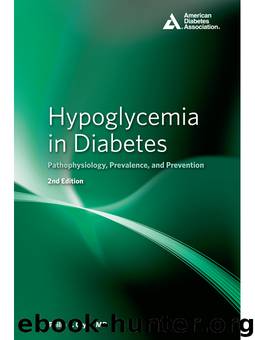Hypoglycemia in Diabetes by Philip Cryer

Author:Philip Cryer
Format: epub
Tags: ebook
Publisher: American Diabetes Association (Perseus)
Published: 2012-03-14T16:00:00+00:00
Chapter 5.
The Clinical Definition and Classification of Hypoglycemia in Diabetes
The GLUCOSE Alert Value
The American Diabetes Association (ADA) Workgroup on Hypoglycemia (2005) defined hypoglycemia in diabetes as “all episodes of abnormally low plasma glucose concentration that expose the individual to potential harm.” That includes asymptomatic hypoglycemia because that also impairs defense against subsequent hypoglycemia (Heller and Cryer 1991b; Fanelli et al. 1998; Davis et al. 1997b). Because the glycemic threshold for symptoms, among other responses to hypoglycemia, shift to lower plasma glucose concentrations in patients with recurrent hypoglycemia and to higher plasma glucose concentrations in those with poorly controlled diabetes (Amiel et al. 1988; Boyle et al. 1988; Mitrakou et al. 1993), it is not possible to state a single plasma glucose concentration that defines hypoglycemia. Nonetheless, the ADA workgroup recommended that people with drug-treated diabetes (implicitly those treated with a sulfonylurea, a glinide, or insulin) become concerned about developing hypoglycemia at a self-monitored plasma glucose concentration of ≤70 mg/dl (≤3.9 mmol/l) (ADA Workgroup on Hypoglycemia 2005). Within the error of self–plasma glucose monitoring (or continuous glucose monitoring) devices, that glucose level approximates the lower limit of the nondiabetic postabsorptive plasma glucose concentration range (Cryer 2001) and the normal glycemic thresholds for activation of physiological glucose counterregulatory systems (Cryer 2001) (Chapter 2), and is low enough to reduce glycemic defenses against subsequent hypoglycemia (Davis et al. 1997b), in nondiabetic individuals. That glucose level is higher than the plasma glucose levels required to produce neurogenic and neuroglycopenic symptoms (50–55 mg/dl, 2.8–3.0 mmol/l) or to impair brain function in nondiabetic individuals (Cryer 2001, 2007) and substantially higher than the glucose levels that do so in people with well-controlled diabetes (Cryer 2007; Amiel et al. 1988), although people with poorly controlled diabetes sometimes have symptoms at somewhat higher glucose levels (Amiel et al. 1988; Boyle et al. 1988).
Use of a 70 mg/dl (3.9 mmol/l) plasma glucose alert level generally gives the patient time to take action to prevent a clinical hypoglycemic episode. Also, in practice, self–plasma glucose monitoring is usually done with devices that are not precise analytical instruments, particularly at low glucose levels (Diabetes Research in Children Network Study Group 2003). The recommended alert level provides some margin for their inaccuracy.
The recommended generic alert level does not mean that people with diabetes should always self-treat at an estimated plasma glucose concentration of ≤70 mg/dl. Rather, it indicates that they should consider actions ranging from repeating the measurement in the short term through behavioral changes, such as avoiding exercise or driving, to carbohydrate ingestion and subsequent regimen adjustments.
The plasma glucose alert value of ≤70 mg/dl (≤3.9 mmol/l) has been criticized as being too high because glucose levels are occasionally lower than that in nondiabetic individuals and its use would lead to an overestimation of the frequency of clinically important hypoglycemia (Amiel et al. 2008). The former is true, especially in women and children. The latter criticism is wide of the mark. The issue is not to estimate the frequency of clinically important hypoglycemia. It is to prevent clinically important hypoglycemia.
Download
This site does not store any files on its server. We only index and link to content provided by other sites. Please contact the content providers to delete copyright contents if any and email us, we'll remove relevant links or contents immediately.
Men In Love by Nancy Friday(5155)
Everything Happens for a Reason by Kate Bowler(4678)
The Immortal Life of Henrietta Lacks by Rebecca Skloot(4525)
Why We Sleep by Matthew Walker(4360)
The Sports Rules Book by Human Kinetics(4294)
Not a Diet Book by James Smith(3336)
The Emperor of All Maladies: A Biography of Cancer by Siddhartha Mukherjee(3065)
Sapiens and Homo Deus by Yuval Noah Harari(2987)
Day by Elie Wiesel(2720)
Angels in America by Tony Kushner(2596)
A Burst of Light by Audre Lorde(2546)
Endless Forms Most Beautiful by Sean B. Carroll(2431)
Hashimoto's Protocol by Izabella Wentz PharmD(2331)
Dirty Genes by Ben Lynch(2272)
Reservoir 13 by Jon McGregor(2242)
Wonder by R J Palacio(2139)
And the Band Played On by Randy Shilts(2129)
The Immune System Recovery Plan by Susan Blum(2027)
Stretching to Stay Young by Jessica Matthews(2001)
